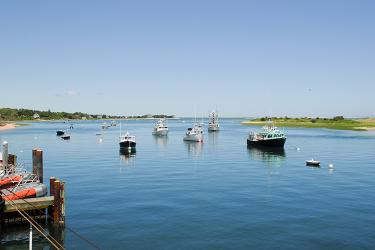1. We conduct surveys from the sky and at sea.
NOAA Fisheries scientists use aerial surveys to count and map the locations of the different species of ice seals in Alaska. We outfit NOAA Twin Otter planes with pairs of cameras, regular and advanced thermal (infrared) imaging, which take thousands of images. Seals can be hard to spot on a vast ice field, but their warm bodies glow brightly against the cold sea ice when viewed in infrared. The images are then analyzed to count seals and learn where the different seal species live.
Scientists from the Alaska Fisheries Science Center also study ice seals with at-sea surveys in the central Bering Sea aboard research vessels like the NOAA ship Oscar Dyson. We explore the zone between open water and sea ice looking for ribbon, spotted, bearded and ringed seals. Our surveys are timed to coincide with the whelping (giving birth), nursing, and pup maturation season.
2. We attach satellite tags to seals to track their movements.
Satellite-linked tags help scientists learn more about seal movements, behavior, and haul-out timing. Pinnipeds “haul-out” when they temporarily leave the water. They may do this for a variety of reasons including to rest, thermoregulate, avoid predators, interact socially, molt, give birth, and nurse their young. This information is critical for calculating population estimates from aerial surveys. We study the seals’ seasonal movements and dive behavior to identify important seal habitat. We tag seals with hind-flipper satellite transmitters, which provides long-term movement data and haul-out timelines. We also attach head- or back-mounted tags to most of these seals using super glue. These tags stick to their fur and will fall off in a few weeks during their annual molt. They provide additional details about locations at sea and seal diving behavior. Diving is an indicator of foraging activity and long periods at the surface indicate haul-out and resting behaviors.
3. New technology, like uncrewed aerial systems, help us study seals in remote locations.
Scientists are developing advanced imaging technology that will enable drones to collect information essential for managing Alaska’s depleted northern fur seal population. This innovation will dramatically reduce the expense and risk of monitoring fur seals, and virtually eliminate disturbance to this sensitive population. Fur seal pups are difficult to count from a visual image, but show clearly in a thermal image captured from a hexacopter.
Studying northern fur seals in remote Alaska
Drone technology that could revolutionize marine mammal monitoring
4. We collect poop–yes, poop!–to learn more about sea lion diets and foraging behavior.
There are many ways we can research Steller sea lion diet and foraging behavior. We study where sea lions go while at sea, and how deep they dive to catch their food, or “prey.” One of the most common ways is to collect their scat, or poop, on land. We can use the hard parts (like fish bones) left behind to identify their prey size and species.
Steller sea lion research in Alaska, Oregon, and California
5. We camp out on remote islands in order to study Hawaiian monk seals (and green sea turtles) without disturbing wildlife.
Small teams of NOAA Fisheries field biologists deploy for 2 to 6 months each year to monitor Hawaiian monk seal populations. They camp at French Frigate Shoals, Laysan Island, Lisianski Island, Pearl and Hermes Reef, Midway Atoll, and Kure Atoll located in the Papahānaumokuāea Marine National Monument. Field teams measure and tag all weaned seal pups, identify all individuals, conduct beach counts of seals, and remove marine debris. They also conduct additional scientific and recovery efforts to protect the Hawaiian monk seal population.
6. We study fatty acids in seal blubber.
Along with studying seal’s scat and their stomach contents, our scientists study fatty acids in the blubber of live or dead seals. This helps us to find out more about what they eat and how this varies by location and over time.
Seal ecology and assessment research in the Northwest Atlantic










